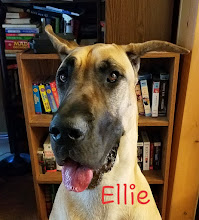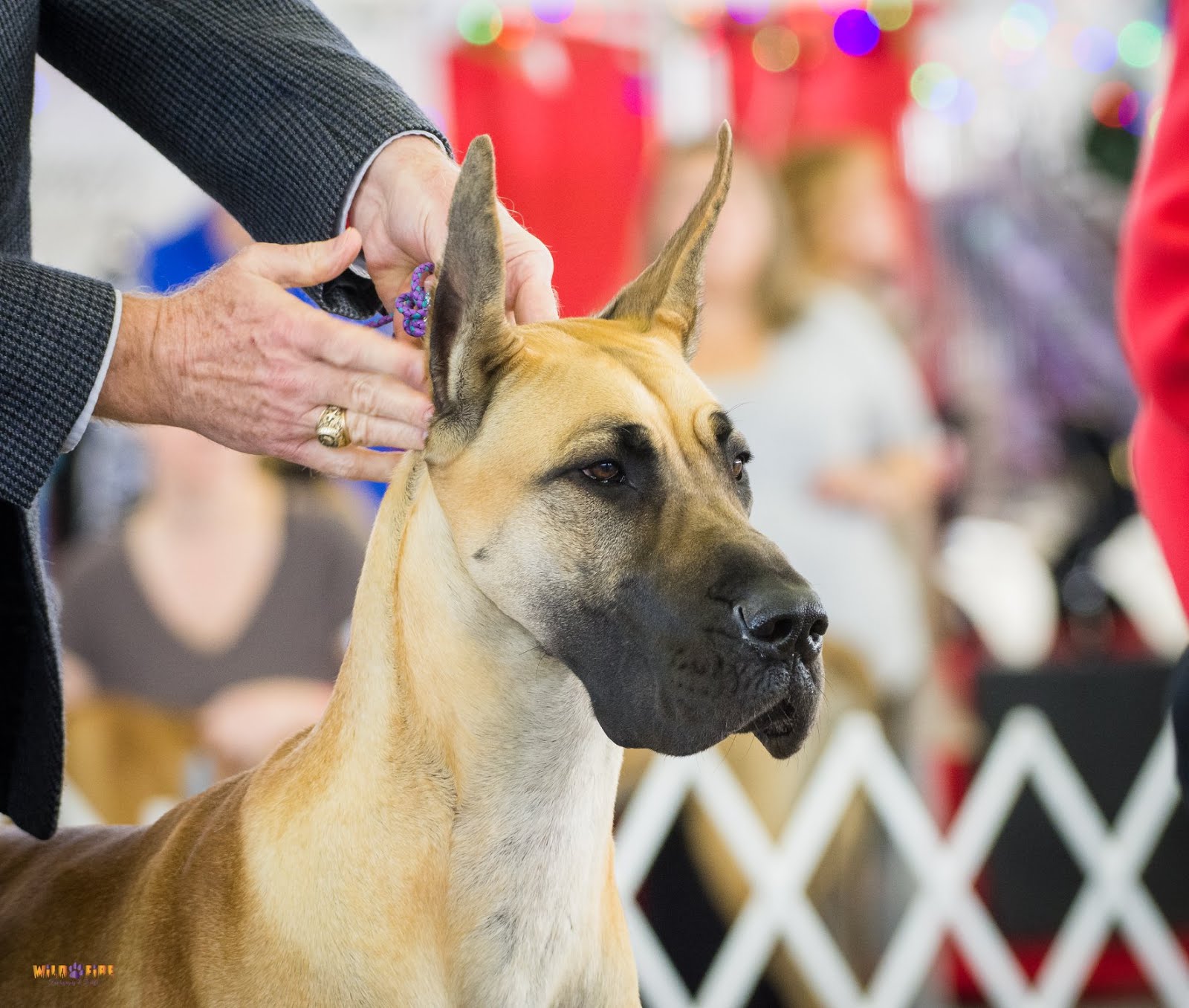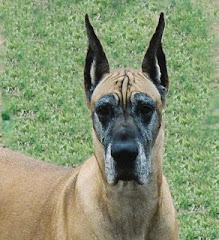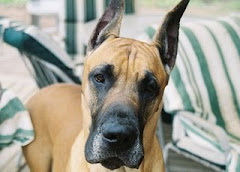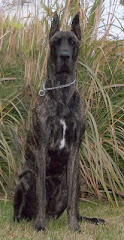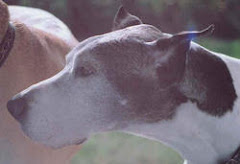Well, is she? If you have an intact (that is, unspayed) female dog, you'd better be able to tell! Living with a spayed female dog, or a neutered (castrated) male dog is easier than living with an intact one. But it's perfectly possible to be a responsible pet owner, and not spay or neuter your dog. Being a responsible pet owner - among other things - means not letting your pet breed accidentally. Breeding dogs is something that should be done using only the best and healthiest dogs possible, and only after some thought about how to select the best possible mates, to produce the best possible puppies. Although there is no shortage of well-bred, purpose-bred dogs; the shelters ARE full of the results of "oops" breedings. These happen when someone's intact male dog gets loose, or someone didn't realize that their female dog was in season and didn't know how to protect her.
I have NO problem with people who don't want to spay their female dog or neuter their male dog, as long as they are willing and able to prevent accidental matings. Managing an intact dog really isn't THAT difficult. But if you're debating whether or not to spay or neuter your dog you should realize that there ARE some inconveniences involved in responsibly keeping an intact pet.
And I've talked to a lot of intelligent people lately who have had basically no idea how to properly manage an intact male or female dog.
So let's cover a few of the basics. This is doggy sex ed 101. (THAT should get a few interesting search results!!! Ha!)
Let's talk about the
boys first since they really are easier. The most important thing to know about keeping an intact male dog is:
KEEP HIM HOME!!!
If he's an escape artist and digs or jumps out of your yard every now and then, or if he successfully manages to bolt out of your front door... or if you just think that it's "good" for dogs to roam free now and then - you definitely SHOULD sterilize your boy!! Even if he's just 4 or 5 months old - that is the age of puberty for many dogs!!
If you don't want to castrate him, you can have a vasectomy done on him. That way if he's really young he'll still have his testosterone for normal growth and development, but he won't be siring litters all over your neighborhood. He'll still want to roam in search of a lady friend, but at least he'll be shooting blanks.
Now, if your dog escapes or bolts out the door or runs away you ALSO need to do some training! Neutering alone won't stop all those problems. But this post is about preventing accidental breeding which is part of the responsibility of owning a pet.
Now for the girls...
Although bitches do have a bloody discharge when they're in estrus (in season or in heat) it's a completely different type of cycle from a human female's menstrual cycle.
On average, a young bitch will come into estrus the first time when she's about 5 or 6 months old, and stay in estrus for 3 weeks (about 21 days). She will repeat this approximately every six months for her entire life - bitches do NOT go through menopause.
Just like in humans, there can be a huge variation in the schedule from one dog to another. Some will have their first heat cycle as young as 4 months - others won't have their first one until they're about 18 months old. Some will have 3 estrus periods in a year, others will only have one. If you have a puppy bitch, the best predictor of when she'll first come into season and how often she'll do it thereafter is to know what her mother/aunt/grandmother's cycles were like. If you can't talk to her breeder to find out, then plan for the worst. Be ready for her to come into season the first time at about 4 months of age, and be ever vigilant after that time.
The first symptom of a bitch coming into heat is usually some swelling of her vulva. She may lick it more than usual. The vulva and the skin around it may turn pink or reddish. Then a bloody discharge will start - in some bitches this can be a heavy flow, in others it is hardly noticeable. If you think your girl might be coming into season, one quick test is to fold a clean paper tower or kleenex and dab her vulva. If you see pinkish or bloody looking spots, then she's starting to come in season.
Some bitches also have personality changes at this time - she may be more affectionate, or more cranky. She may not tolerate other dogs very well. I had one young bitch who became very destructive when she was in season. Your other dogs - even females or neutered males - will be more interested in her and want to sniff her rear. She may get tired of this and start to get snippy - you may have to separate her from all other dogs while she's in season to prevent fighting. Don't punish her for any behavior changes during this time, just don't let other dogs bother her, and don't expect her to do her normal work (training, showing etc) during this time if she doesn't seem to be willing to do it.
After a few days - up to a week or so - the bloody discharge will taper off and you'll see a clear or pinkish discharge.
This does NOT mean that she's going out of season!! Rather, she's probably about to ovulate and is entering the most fertile time of her cycle.
BUT - and I cannot emphasize this enough - unless you do hormone testing you CANNOT predict exactly when during her cycle the female is fertile.
YOU MUST KEEP HER STRICTLY AWAY FROM ALL INTACT MALE DOGS DURING HER ENTIRE HEAT CYCLE.
This means no contact from the INSTANT you even THINK she might be coming into season.
This means no contact at all - dogs CAN and HAVE managed to copulate through a chain link fence, baby gate, or during a 3 minute phone call when the owner wasn't paying attention.
This means ANY male dog - even her father, her brother, her uncle, her son. Dogs do not have sexual taboos, and do not recognize or understand the concept of "incest".
This means keep her on a leash when you take her out to potty, and don't take her off your property. A loose running male dog can and will mate with her while she's on the end of your leash! Only let her off lead in an absolutely securely fenced area, and even then only after you've checked to be sure no male dog has managed to get into the area. Even then, keep your eyes on her. Don't leave her unattended outside AT ALL.
This means you must keep her in the house even if she's normally an outside dog. It IS possible to build a kennel secure enough to keep out an amorous dog trying to get to a bitch in season, but it's expensive and difficult. It MUST have a secure roof unless the walls are 8 feet high and absolutely un-climbable. It should be enclosed within your property fencing, so there is a "buffer zone" around it. It also must have a barrier buried around the edges to prevent a dog digging underneath. It's much easier to just keep her inside.
This means separating her from male dogs for at least 3 FULL weeks (at least 21 days) - she may still be able to get pregnant just when you think she's going out of season.
Inside your home, her discharge may be messy. You can keep her confined to a crate, pen or room covered with washable blankets and bedding, or you can teach her to wear a dog diaper (
Seasonals are a good brand, there are lots of others) to keep her from dripping all over your house. I start teaching female puppies to wear diapers when they're 3 or 4 months old, I just put them on for a few minutes at a time when they're about to eat a meal which will distract them. Gradually increase the time they wear them, and by the time they have their first estrus cycle they won't mind wearing their "panties". Get several pairs, and wash them frequently. If your girl has a heavy flow, you'll need to put an adhesive menstrual pad inside the diaper - but be watchful that she doesn't remove it and try to eat it!! The absorbent materials in sanitary napkins can cause an intestinal blockage. Usually I find that the diaper itself provides enough protection. I change them at least twice a day.
I know this sounds like a lot, but even managing an intact bitch really isn't THAT difficult. Keep her inside and away from male dogs is really what it boils down to when it comes to preventing accidental breeding.
Do you think you're up to it?
 This is a pretty typical scene at feeding time. Except she's not always this patient, and will sometimes start knocking things off the counter if the food doesn't start appearing quickly enough.
This is a pretty typical scene at feeding time. Except she's not always this patient, and will sometimes start knocking things off the counter if the food doesn't start appearing quickly enough.












 But I like this picture that the photographer sent us better than the one they ended up using on the package:
But I like this picture that the photographer sent us better than the one they ended up using on the package:









